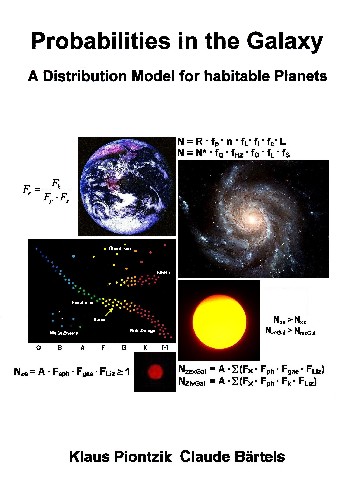| Impressum | Disclaimer | https://www.probabilities-in-the-galaxy.com | SiteMap |
| In order to make
the model of the distribution of life and intelligence in
the galaxy accessible to a wider public, i have decided
to put the mathematical part of the model largely on the
Internet. As much of the model is published as necessary
to implement the model. However, the references in the
text can only be looked up in the book.
Individual parts in the following Register are marked as "supplement". These parts are included in a new version. |
| Page | ||
| Introduction | 8 | |
Part 1 - The Basic Model |
Part 4 - Additional Considerations |
||
| 16 | The SETI-Project | 139 |
| 16.1 | The History of SETI | 139 |
| 16.2 | Signals | 143 |
| 16.3 | Operating Time of SETI | 144 |
| 16.4 | No Answer | 144 |
| 16.5 | Quantum Technology | 145 |
| 16.6 | Distribution of Starsystems | 146 |
| 16.7 | The best Case | 147 |
| 16.8 | Distances and Periods | 148 |
| 16.9 | Consequences | 149 |
| 17 | A look into the future | supplement |
| 17.1 | The Kardashov scale | supplement |
| 17.2 | Future Levels of a Civilization | supplement |
| 17.3 | Daughter Civilizations | supplement |
| 17.4 | Expansion of a civilization | supplement |
| 17.5 | Expansion of civilizations | supplement |
| 17.6 | Expansion of humanity | supplement |
| 18 | The Fermi-Paradox | 150 |
| 18.1 | The Considerations of Fermi | 150 |
| 18.2 | The Situation today | 150 |
| 18.3 | Possible answers | supplement |
| 18.4 | Worst Case | supplement |
| 18.5 | Conclusion for future encounters | supplement |
| Bibliography | 152 | |
| Images Directory | 161 | |
| List of Names | 165 | |
| Persons | 165 | |
| Telescopes, Radio Telescopes | 166 | |
| Instutions | 166 | |
| Satellites, Space Station | 166 | |
| Astronomy | 167 | |
| Epochs | 169 | |
| Races | 169 | |
| Human Development | 170 | |
| Locations | 171 | |
| Keyword Index | 172 | |

|
176 sides, of them 64 in Color 76 pictures 11 tables Production and publishing: Books on Demand GmbH, Norderstedt ISBN 9-783-7528-5524-1 Price: 22 Euro |
|